#the pharmacist says it's a national shortage
Text
Should finally be able to restart the most important of my meds, providing there are no further issues with supply in my pharmacy and/or the psychiatrist not calling me back.
#the pharmacist says it's a national shortage#the psychiatrist says none of her other patients are having problems with their pharmacies#it's all so fun and easy to navigate 😭#(in before 'go to another pharmacy' I have to go to this one bc of the scheme I am in to get financial assistance with paying for meds)
7 notes
·
View notes
Text
for those of yall who have ADHD and take medication, a protip: there’s a national shortage of stimulant meds in the US right now because the FDA is fucking incompetent. you need to start calling pharmacies to see if they have any stock of your meds, and then call your doctor and tell them to send your prescription to that pharmacy.
notice I did not say ‘you need to start calling your local pharmacies.’ no. I mean literally anywhere you can possibly get to. I just called 8 different pharmacies within a range of 138 miles. none of them have my meds in stock. good luck and godspeed you pitiful neurodivergents.
(protip2: here’s your script for talking to pharmacists “I’m calling to ask if your pharmacy is currently able to fill [whatever prescription].” you’re welcome.)
193 notes
·
View notes
Text
Is 6.5% enough?
Today, there was a leak in the Times that said the independent body who make recommendations on teacher pay has recommended a pay rise of 6.5% for teachers in England for September. Obviously, we don’t know all the details, and funding is a key issue, but is 6.5% enough to save education?
Anecdata, but I recently met up with some friends from my teacher training course. We’re close to hitting the 5 year mark- by which point 1/3 of teachers apparently quit. Except I’m going to be the only one out of five of us teaching in England in September, an attrition rate of 80%. And I don’t think that attrition rate is so unusual, any more.
Right now, on one of the main websites which schools use to advertise vacancies, there are over 12,000 teaching/education jobs being advertised in England. It’s very roughly one vacancy for every two schools. These vacancies won’t be evenly distributed between all schools, so there will be schools in September with huge staff shortages. It’s not an exaggeration to say education is in crisis.
If we got 6.5% (and if it were funded, ensuring all teachers could receive the pay rise), would it make any difference? It’s lower than inflation, after all, and many of the things that we regularly need to buy have gone up by more than inflation in the past year.
As a brief explanation, most teachers in England are paid according to one pay scale. People get a bit more in Inner/outer London and the surrounding areas, but otherwise there’s one set of pay for the whole country. All teachers progress from the starting point M1, to M6, usually at the rate of one pay point a year. The 6.5% would be added on to all of these paypoints.
6.5% would bring M1 (the starting pay point for most qualified teachers) very close to the original Tory promise of a £30,000 starting salary for teachers. At the top of the main pay scale- M6 (which is the point at the pay scale where this would have most impact) it would increase salaries by over £2000 to £41, 332. This would be noticeable in pay packets, enough to reduce people’s financial stresses- which can enable them to cope better with a stressful working environment.
I know some of you will say £40k is a lot, but bear in mind we are talking about a postgraduate qualified professional with at least 6 years of experience. For someone with a chemistry, physics or maths degree, that could be their starting salary in industry. It’s about equivalent to the average salary of a pharmacist. In a capitalist system, pay has to be competitive.
After M6, to increase your pay, you either need to get onto the “upper pay scale” or take on an extra responsibility payment known as a TLR. Getting on to the upper pay scale used to be relatively automatic, but now it’s much harder. It can certainly take people two or three years to progress from M6 to upper pay scale, and you’re expected to take on “whole school responsibilities” which can amount to a lot of extra work, with not that much of an increase in pay. Increasingly, in England, teacher pay is capped at M6, although there are a lot of older teachers who are on the upper pay scale, and sometimes, they find themselves getting pushed out because they are too expensive. If you move schools, there’s no guarantee of getting a UPS pay point at the new school.
TLRs are even worse in many ways. This is the way that people like heads of department and heads of year are paid. It’s a figure set by your school, within a national range, and there’s no consistency between schools. A Head of Science in one school may get £5000, whilst another only gets £3000. It’s worth noting that it’s also much harder to get a TLR in primary. Because TLRs are often the only way to increase your pay, a lot of people rush to take them on, sometimes in the second or third year of teaching. This often leads to burnout, because people take on massive responsibilities before they are ready, and the consequences can be damaging to everyone around them as well.
I do think 6.5% might be just enough to keep some people who are looking elsewhere from leaving. But the main reason people leave is often work related stress, often euphemistically called “workload”, which is largely being driven by the collapse in other services such as social services, the NHS and social care. “Workload” is also often made worse by being in a short staffed department, so it becomes a vicious cycle. I’ll write more about workload in another post.
However, the point is, the profession is on the brink of collapse. I really do believe that. I think the only way to save education would be to tempt a lot of the recent leavers back in. And 6.5% won’t be enough to do that. I don’t think 10% would be enough to do that. Without tackling the systemic problems within teaching, and without a pay system that really rewards classroom teachers doing the key, every day job that makes education functional, pay increases that don’t even match inflation aren’t enough.
35 notes
·
View notes
Text
Last week, the Labour MP Darren Jones needed antibiotics for a sick child. It took him and his wife eight attempts in two cities, he reported on Twitter, to find a chemist that could fill the prescription.
Class WhatsApp groups, Mumsnet threads and school-run conversations have been filling up over the past few days with stories like these, thanks to an increase in strep A infections – a common bug that usually just causes a sore throat but can in rare cases be fatal for children – leading to parental panic and GPs writing more prescriptions to be on the safe side. The health secretary, Steve Barclay, insists there are more than enough drugs for everyone, but right now they don’t seem to be reaching the high street fast enough, with parents reporting dashing from pharmacist to pharmacist trying to get a prescription filled.
Meanwhile, shortages of HRT medication are being reported again, after a drought last year that saw menopausal women furtively sharing stocks with friends or even trying to buy on the black market. And if it’s not drugs, it’s something else. Over the past few years a combination of Brexit, the pandemic, the wedging of a giant ship in the Suez canal that caused temporary havoc to global shipping routes, and more recently a bird-flu outbreak affecting poultry farmers, have led to temporary panics over the availability of everything from loo roll to iPhones, fresh fruit to eggs.
Minette Batters, the president of the National Farmers’ Union, warned last week that Britain could be “sleepwalking” into a food supply crisis, with pending problems for everything from pig production to growing tomatoes, cucumbers and pears. The next shortage on the horizon may be electricity, with some smart-meter customers being incentivised to curb peak-time usage to help us through a spell of cold, dry weather.
Britain is used to being a country where those with the money to pay for it could generally have what they wanted, when they wanted it: a place of just-in-time supply chains and bursting shelves, doorstep delivery and cheap credit, convenience and choice. But now we’re having to adjust to more of a scarcity mindset, accepting that niggling absences and even occasionally rationing may be a fact of life. By global or by historical standards western lives are still obviously luxurious. But having got used to a life of convenience, the idea that things may not always necessarily be available when we need them creates a steady throb of anxiety below the surface.
People used to laugh at “preppers”, those paranoid survivalists who stockpiled tinned food and battery-operated torches ready for a vaguely imagined apocalypse. But it stopped feeling so funny when one of the earliest temporary pandemic shortages involved a run on freezers in which to hoard food, and now we’re all sheepishly stocking up on candles and solar-powered chargers in case of January power cuts.
Meanwhile, prepping itself has had a makeover thanks to a rash of Instagram “homesteading” influencers, young women living on ranches in the American midwest who post endless reels of themselves canning peaches, growing squashes and raising chickens like something out of a Laura Ingalls Wilder book. What they’re pitching is a romantic vision of self-sufficiency that hasn’t been this popular since the equally unpredictable 1970s, the last time the homespun “good life” was heavily in vogue, where security means having what looks like a lifetime’s supply of tinned beans in the cellar just in case. Their popularity is, I suspect, down to the fact that they’re oddly soothing to watch, and right now it’s soothing we need.
For scarcity tends to breed anxiety about what may be around the corner, and sometimes a culture of every man for himself. There was no national shortage of petrol in the autumn of 2021, either, but the fear that there might be soon – thanks to a shortage of tanker drivers – scared people into filling up en masse just in case, thus temporarily creating precisely the shortage we’d each been trying individually to avoid. As ministers quickly discovered, once that kind of doom loop sets in, it’s very hard to stop; telling people not to panic just alerts them to the fact that other people must be panicking, and if you think something vital is about to run out then you’ll be, if anything, inclined to grab it before someone else does.
But we’re going to have to learn to adapt somehow, because shortages and interruptions and unexpected absences are almost certainly here to stay. Shifting patterns of global trade, the climate crisis affecting food production, and ongoing disruption to manufacturing, particularly in China – which faces the prospect of a huge Covid “exit wave” as it abandons restrictions in the face of the Omicron variant – are all likely to have knock-on effects. The age of inconvenience, in short, is with us for a while yet.
13 notes
·
View notes
Text

Throughout my life, I’ve written letters, addressed them to God, and dropped them off at the post office. I did this when my first son died, when I got divorced, and when I finally attained my bachelor’s degree after being a single mom. I never included a return address or a clue to my identity. This was just my message in a bottle, so I felt like Heaven heard me…
Today, I thought about this at the pharmacy. Mike had tried getting my prescription, but there are national shortages on many medications—and mine are some of them. “They ran out,” Mike said, coming back to the car. “Sorry that took forever; there’s a huge line.”
“But… my oncologist called yesterday. They have just enough for 18 days.” And then I did something I rarely do in front of Mike; I cried.
We walked back into the pharmacy to see six people in line, and as we stood there, my right leg began to shake. “You should go sit down.”
“It’s okay,” I told Mike. “I don’t wanna miss when it’s our turn.” They hadn’t listened to him. Maybe they would listen to me.
At different points, each person in front of us glanced back. They all seemed around my age (40) or younger, healthy, probably doing some Christmas shopping. Then, I had the audacity to think, “Why don’t they offer to let us go ahead? Mike was just in here. And I can barely stand this long.”
One man in line called his mother and complained while we waited. “Hi, Mom.” He paused. “Yes. Just at the pharmacy. There’s a huge line.” Another pause as he glanced back, listening to her reply. “Right?! He said he can’t even face his friends unless he gets a new gaming system this year.” He exhaled with such force that I clocked it at 50 mph. “Oh! And you know I take Nicki on a shopping spree every year? It just never seems to be enough. I hate this time of year. Are all women that needy? No wonder men joke about marriage.”
Mike looked at me and smirked. I plastered a smile onto my face, but it felt subpar. I thought of this woman, “Nicki.” Meanwhile I’m just praying for another week, another day, another moment with my family.
After a bit longer, they called us up and my leg shook so badly that I held the counter in a death grip. “I have terminal cancer,” I said, my eyes pleading with the pharmacist and my knuckles turning Porcelain 10.
“It’s for Magagna, right?” He looked at Mike, remembering him from earlier.
“My oncologist called yesterday and said you have enough for 18 days,” I begged.
“But like I told your husband, we can’t fill this for the full 30 days. We don’t have enough for this prescription.”
“My doctors’ office is closed for the weekend, and I’ll be out of this tomorrow. If it’s not too much to ask, can I please have the 18 days?”
He typed something into the computer, and my breath stopped. He practically held my life in his hands. “This’ll take about 15 minutes. I’ll come get you when it’s ready? You can take a seat over there.”
I noticed then how stressed the pharmacist looked. “I’m sorry about the line,” I suddenly said. “This must be a stressful day for you too. Thank you for your help.”
His peered at me and Mike, his eyes widening with disbelief. “What you're both going through is so much worse. I’m sorry you have cancer.”
“Well, let’s just say I didn’t ask for it.” I tried to laugh, but it came out like a hiccup. Then I turned away.
Mike decided to shop for some ice melt, and as I walked toward the chairs, I fought falling into the throes of irony. A private corner seat, behind a display of reading glasses, seemed ideal. I felt secluded as I mulled my thoughts. Why had this hit me so hard? Then it came to me, the thing I’d said to the pharmacist: “Let’s just say I didn’t ask for it.”
One of the hardest things about cancer is knowing it can affect anyone. I’d gone from participating in marathons to barely being able to walk to my mailbox. I faced the pharmacy’s northwestern wall and tears flooded my cheeks. I have terminal cancer. And there’s no denying it. Every moment in pain is a reminder.
God, not this! Not here. Wiping my face with my scarf, I dug a medical bill from my purse and flipped it over. “Dear God,” I wrote, hoping to calm down.
Dear God,
I didn’t choose this situation, and right now that’s hard. I don’t want to have terminal cancer anymore. I want a day where I don’t feel sick at all. Even ONE day. Just to remember what that was like. I’ll appreciate it so much. God. I feel trapped in my own dying body.
I hate knowing that without certain medicine I’ll die. I hate that these are my fears while some man’s wife is upset that she won’t get as much STUFF as she did last Christmas. Seriously?! I need strength. Strength to stop judging people.
Strength to keep getting cancer treatments. Strength to not complain and let this turn me into a bitter person with a curdled soul. No one can uncurdle milk! (Well, I guess YOU can.) But anyway…
Another person called last week and said I should quit getting treatments because I don’t have a quality of life. I laughed at first, but on my hardest days, I remember their words and it’s hard to keep going.
God… I’m sorry to be so judgmental. I really am. I’m working on it.
AND… if it’s not too much to ask, can you please give me strength? I know you’re gettin’ a lot of requests though, so if you can’t, I understand.
-Elisa
—
At that moment, I glanced toward the counter and spotted a woman who looked 10,000 times worse than me. She’d lost her hair and probably weighed 100 pounds—even with her walker. She could barely walk and hunched so badly; I wanted to pick her up in my arms and hold her tight. Why hadn’t I looked back when I was in line? Why hadn’t I offered to trade HER places? Screw my aching hips and shaking leg. Why hadn’t “I” done more? Then the answer came: Because I was too wrapped up in my own problems. And that’s exactly why other people hadn’t offered to help me…
Woah. Mind blown…
I suddenly felt sympathy for the man whose family always wants more. I felt bad for his wife who doesn’t know what really matters. I felt even more compassion for the pharmacist who’d just been yelled at and wiped sweat from his brow. And I felt a bit of strength come with every second that I stopped focusing on myself.
“You wanted to swing by the post office?” Mike asked as we walked out of the store.
I looked at the letter I’d written on a medical bill. It simply had my first and last name above all of the numbers. For the first time, I’d broken my one rule: to never write a letter to God that included personal information. “No, it’s all right. We can just go straight home,” I said.
With one hand, I crumpled the bill and threw it into a big garbage can at the front of the store. God had already answered my prayer. He’d given me strength AND empathy. I guess He really can hear us anywhere, even in a pharmacy in southeastern Idaho. Plus, He didn’t charge for same-day delivery or anythin’.
For more posts like this, please follow my page at https://m.facebook.com/realecstilson .
#mentalshift#realization#joy#TerminalCancer#CancerPatient#Melanoma#Stage4cancer#FindingHope#BeingPositive#INeedHope#FindTheGood#ecstilson#loss#death#grief#inspiration#inspirational#inspirationalthoughts#motivation#motivational#motivationalspeaker#persevere#newnormal#normal#melanomaawareness#cancerwarrior#goodness#hope
0 notes
Text
Wisconsin pharmacists say they need more help to keep up with increasing demands
National walkouts aside, pharmacists are dealing with increased burnout, shortages form manufacturers, patient harassment and more. Could this impact patient safety?
By Hope Kirwan | Wisconsin Public Radio
Norbert Salamonski recently retired from working as a pharmacist at Walgreens in Marshfield. Based on his experience, Salamonski said he’s not surprised to see pharmacists and technicians walking out at retail pharmacy chains across the country.
After walkouts at CVS stores in September and at Walgreens earlier this month, national media outlets reported…

View On WordPress
0 notes
Text
'Big year' for pharmacists with new prescriptive powers, drug shortages: association
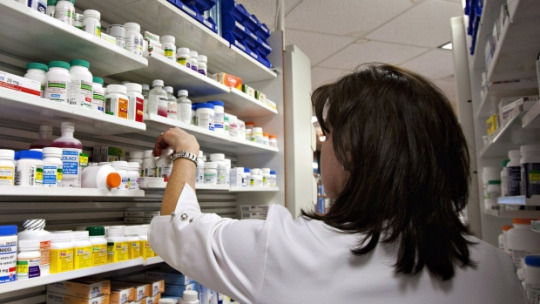
In a year when pharmacists have faced children's drug shortages and an extra-busy flu shot season, you'd think they might balk at the news in Ontario and B.C. that their prescriptive powers are being expanded. Yet those in the field say the added responsibilities may make their jobs more fulfilling — so long as the changes are accompanied by appropriate funding.
"Pharmacies are trying to do a lot with limited resources," said Danielle Paes, chief pharmacist officer at the Canadian Pharmacists Association. "Appropriate funding is a key part of ensuring that these expanded services are not only sustainable but utilized by the public."
Amid the COVID-19 pandemic and family doctor shortages, pharmacists have seen their roles in the healthcare system recognized by governments and the public like never before, Paes said. They've become key points of contact for everything from COVID-19 vaccinations to renewing some drug prescriptions. At the same time, the triple threat of COVID-19, influenza, and respiratory syncytial virus, or RSV, is taking its toll on staffing levels, while shortages of children's pain and fever medication prompted some pharmacies to keep new shipments behind the counter last month to limit hoarding by fearful parents.
"It's been a really big year," Paes said. Like many health professionals, pharmacists have faced burnout and staff shortages since the COVID-19 pandemic began.
In early 2022, a survey of 1,399 pharmacists and pharmacy technicians commissioned by the association found almost all pharmacy professionals — 92 percent — reported being at risk of burnout. Nearly half report abuse or harassment from patients weekly. At the time, Paes said the unrelenting demands coupled with added administrative burdens and staffing challenges had pushed pharmacists to a tipping point. Now, she said the association is planning another survey and hopes the results will be different.
"Hopefully, it's improved, but who knows — it's a rough time to be a healthcare worker right now." As strains on the health system worsen, some governments have turned to pharmacists as a relief valve.
In October, British Columbia pharmacists began administering more vaccines and renewing prescriptions for up to two years for people whose family doctors had left their practices. This spring, they will be di drugs for minor ailments like urinary tract infections and allergies, as well as contraception. Ontario also expanded pharmacists' prescribing powers to include medications for minor diseases as of Jan. 1. They introduced prescribing the COVID-19 treatment Paxlovid.
Paes called it "natural and organic" since pharmacists already have the training. "As a national association, we've heard from pharmacists that they want to practice to their fullest scope. You know, it brings a great deal of fulfillment."
The changes are in line with Health Canada's guidelines and other sections. According to her, funding for the models varies across the country.
She pointed to P.E.I., where an expansion of patient assessment and prescribing powers was announced in October, as a positive model. The service is funded by the government, she said, so patients don't have to pay out of pocket. "We're not there yet with all of them. So even though some authority has been given to pharmacists to provide extensions or renewals on certain prescriptions, they're not always covered."
Last week, Yukon announced that it was also allowing pharmacists to prescribe medications for minor ailments. This made permanent an expansion that had been ongoing since May 2020. In Alberta, pharmacists have had more leeway for more than a decade, including allowing them to administer things like cosmetic injections and order lab work.
Margaret Wing, CEO of the Alberta Pharmacists Association, said that being empowered to operate closer to their full potential made the job easier when pressures mounted. For example, amid the shortage of children's pain and fever medications, pharmacists in Alberta were able to compound alternative remedies. This is because they mix the same active ingredients sold in manufactured products. They could then do patient assessments and prescribe products, she said.
In other provinces, the process was complicated by requiring doctors to issue prescriptions or seeking regulatory changes through Health Canada. This was to allow pharmacists to write the scripts, she said. "There's been, I think, an opportunity within our environment that made it a little more seamless for them to practice in these difficult, high-demand, high-stress environments because of the existing scope (of practice) that they've had for 15 years."
Alberta pharmacists have also played roles in vaccination campaigns, administering about 80 percent of flu shots and 55 percent of COVID-19 vaccines, she said. There is an overwhelming need for health workers in the system, and pharmacists aren't immune to burnout. However, being able to utilize their abilities has helped, Wing said. It means they're better able to meet the needs of their patients, she noted.
"What I've heard from pharmacists is that it helps in the sense that when you can care for your patient right there, and not have to pause and try to connect with a physician who is unavailable," or who hasn't followed through on writing a prescription. "When you have a patient standing in front of you, they need to refill their medication, they can't get it from their physician, and you have the authority and the ability to do that — that makes your work as a practitioner a lot easier."
0 notes
Text
Short supply: Maritimers experience lack of adult medication
Like other Maritimers, Blain Henshaw has spent the last week searching for medicine at nearby drugstores. He says the hunt hasn’t been easy.
Henshaw didn’t find what he had been looking for until visiting his seventh store.
“It’s been hard. It’s been probably a week and we’ve been sick a little over a week and every drug store that you go into there’s nothing on the shelves,” he said.
Henshaw is not alone.
Pharmacies are experiencing a run on most adult medications.
The shelves at Halifax's Boyd’s Pharmasave are normally fully stocked, but selection has recently been running thin.
“There hasn’t been any one particular category that we’ve noticed some shortages. It’s been sprinkled throughout the different types of medication,” said Greg Rishard, pharmacist and owner of Boyd’s Pharmasave.
A national supply chain issue is being blamed for the shortages, which was first seen with children’s medicine.
“Antibiotics to hormones to medications used to treat mental illness. There’s lots of different types of shortages,” said Rishard.
While shortages can be common certain times of the year, pharmacies are noticing more of this recently - causing pharmacists to find alternative solutions.
“If it’s a prescription product we can converse with the physician or nurse practitioner and find solutions on other medications that are appropriate,” said Rishard.
While Boyd’s Pharmasave is limiting the purchases of pediatric medication per family, this does not apply to adult medication.
However, that is subject to change in coming months if shortages continue.
from CTV News - Atlantic https://ift.tt/BbNPlLH
0 notes
Text
FDA confirms Adderall shortage in the US
New Post has been published on https://medianwire.com/fda-confirms-adderall-shortage-in-the-us/
FDA confirms Adderall shortage in the US
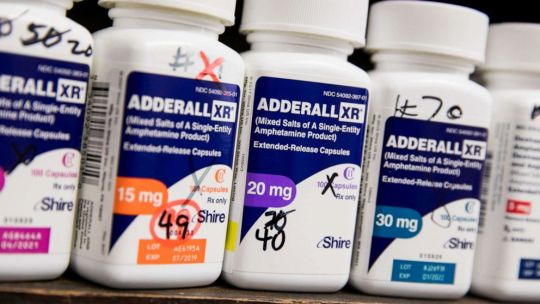
After weeks of individual reports of frustration with getting Adderall prescriptions filled, the Food and Drug Administration confirmed Wednesday a nationwide shortage of the immediate release formulation of amphetamine mixed salts, commonly referred to by the brand name Adderall.
Adderall is a stimulant medication that can treat ADHD. It requires a prescription and as a controlled substance, supply is strictly monitored, and distribution is limited.
Some individuals already knew there was a problem having reported going weeks without medication and calling multiple pharmacies to fill prescriptions. Some patients have had trouble filling Adderall prescriptions since August.
“It’s like the feeling when you first wake up in the morning, and you can’t quite think, except all day long for me without [Adderall]. It really affects my life,” Daryl Linley, a Wheat Ridge resident, told ABC’s Denver affiliate, KMGH.
Signage is seen outside of the Food and Drug Administration (FDA) headquarters in White Oak, Md, Aug. 29, 2020.
Andrew Kelly/Reuters, FILE
Teva, the largest maker of generic Adderall in the U.S., told ABC News “the supply that we are manufacturing/distributing right now is on pace to be consistent – or greater than – our supply at this time last year by the end of this year. The demand is not.”
The company said they are experiencing “intermittent backorders” as “there has been a significant rise in national prescription rates, this can cause some constraint to product availability.” Teva says disruptions will only be “temporary” and expects inventory to recover within months.
Major retail pharmacies like CVS and Walgreens have also noted supply chain constraints. A CVS spokesperson told ABC News they are “aware of intermittent shortages of generic amphetamine medication in the supply chain,” adding their pharmacists “will work with patients who are prescribed this medication as needed.”
While another supplier of the drug, Sandoz Pharmaceuticals (a division of Novartis) told ABC News there is no “shortage” of Sandoz amphetamine (generic Adderall) in the market at this time and the company is meeting all current customer orders.
The constraints on the supply have led to many voicing the challenges of getting their prescriptions filled at their regular pharmacy.
In Kentucky, a Fayette County school board member, Stephanie Spires, said the issue was “significantly impacting our classrooms,” at a meeting Monday.
“I talked to a parent today who said she was able to get five pills,” Spires said.

Bottles of Adderall XR prescription pharmaceuticals photographed in a pharmacy in Remington, Va., Feb. 26, 2019.
Sipa USA via AP, FILE
The shortage of this key treatment for so many Americans, especially kids, comes as the new school year kicks into gear. The CDC estimates that almost 10% of children have ADHD as of 2019, and these numbers may have increased during the pandemic.
There are many reasons for constrained supply, including tight regulation due to its classification as a schedule II drug which the DEA defines as “drugs with a high potential for abuse, with use potentially leading to severe psychological or physical dependence.” In addition, labor shortages, supply chain issues and an increase in the number of people who have been prescribed the drug in recent years may have an effect on supply.
“While stopping Adderall is generally not life-threatening, rebound symptoms, including inattention, hyperactivity and impulsivity, may return and be distressing,” Dr. Anish Dube from the American Psychiatric Association told ABC News.
Doctors and law enforcement officials warn that people should never buy Adderall outside of a pharmacy – including from a friend, as these pills may be counterfeit and/or laced with other lethal substances. The DEA says many fake pills, containing fentanyl, are made to look like prescription stimulants like amphetamines (Adderall) but could be potentially deadly.
If people are struggling to obtain their medication and feel they’ve exhausted all options, they should call their pharmacist or doctor to discuss a plan.
“Those with more severe symptoms should discuss contingency plans with their psychiatrists on how to manage symptoms without medication,” said Dube.
A “classroom of kids who have had to quit their meds cold turkey because they can’t get them – we’ve got some issues going on and brewing here,” Spires, in Kentucky, said. “And it’s not just kids, it’s adults as well. But for us in our purpose here, is children that are not getting what they need, or not coming into the classroom prepared to learn – and it creates a stressful environment for all involved.”
In their announcement, the FDA said they would “continue to use all the tools we have available to help keep supply available for patients.”
Read full article here
0 notes
Note
Can the US actually allows it's citizens to import drugs from us? Or would Canada have to give them permission first?
U.S. plans to allow importing prescription drugs from Canada
The administration of U.S. President Donald Trump said Wednesday it will set up a system to allow Americans to legally import lower-cost prescription drugs from Canada, weakening a longstanding ban that had stood as a top priority for the politically powerful pharmaceutical industry.
Health and Human Services Secretary Alex Azar made the announcement Wednesday morning. Previous administrations had sided with the industry on importation, echoing its concerns that it could expose patients to risks from counterfeit or substandard medications.
Azar, a former drug industry executive, said U.S. patients will be able to import medications safely and effectively, with oversight from the Food and Drug Administration. The administration's proposal would allow states, wholesalers and pharmacists to get FDA approval to import certain medications that are also available in the U.S.
[...]
The Canadian Pharmacists Association was one of the signatories to that letter, and spokesperson Joelle Walker says her organization has expressed concerns "for a number of months, and even years," about the potential for importation of medications into the U.S., "because our market size is not equipped to supply another market that's 10 times our size.
"We already know that Canadians suffer from serious drug supply issues and shortages," Walker told CBC News in response to Wednesday's announcement. "One in four Canadians report [in a national survey conducted last November] that they have experienced a drug shortage, either personally or a family member, and pharmacists from across the country are saying that shortages have vastly increased in the last three to five years, so our supply chain is already not consistent in Canada.
"This has the potential to really put a lot of pressure on the availability of medications in Canada," whether through wholesale imports or individual purchases, said Walker.
41 notes
·
View notes
Text
The Pharmaceutical Industry in India at The Current Moment and Challenges
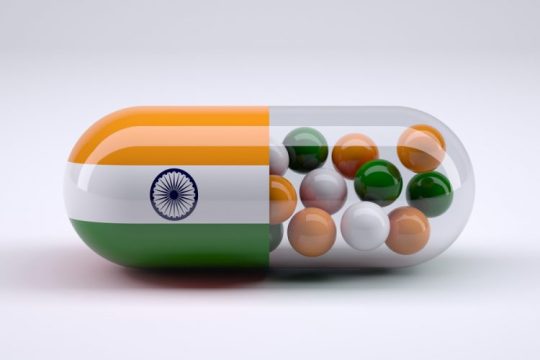
The Indian pharmaceutical industry has witnessed significant growth over the last couple of years. The country has become one of the leading destinations for generic drugs, and the pharma supply chain in India plays an integral role in this growth story.
However, India's pharma sector, or you can say that the pharma supply chain in India, is currently facing challenges such as getting access to international markets, land acquisition issues, and poor law and order situation.
With immense opportunities in the global market, there are chances that these challenges can be overcome, which will open up new vistas for the pharma supply chain in India and global players who are looking to invest in the industry here. Introduction
The pharmaceutical industry is like the backbone that supports its growth in any country. The pharma supply chain in India is a fast-growing industry that contributes to a big part of a nation's overall national healthcare system.
In developed countries, it is estimated that 12% of their annual budget is spent on health care. With more than a 50% increase in population over the last decade, India has an opportunity to grow as a nation when it comes to healthcare expenditure. Yet our country still struggles with providing affordable quality medicines to all its citizens. Present Scenario
The pharmaceutical industry is a major sector of India's economy. The Indian pharmaceutical industry grew at an average rate of 15% annually from 2000 to 2010.
It is ranked 4th largest producer in the world and constitutes 10% of GDP. Growth has been on an upswing in recent years, growing by 11% annually from 2010–11 to 2020-21. Future Outlook
The supply chain is one of our core functions in a fast-changing environment. We have to ensure that we meet today's demand and support tomorrow's goals by aligning our supply chain and manufacturing functions.
The Pharma supply chain in India is going through fundamental changes that redefine how organizations manage their business. With increasing cost-consciousness and pressure on margins, players across all segments adopt a 'just-in-time' strategy for working capital management. Key Takeaways
There is a clear move toward Formulation Development Outsourcing (FDO) for nearly all pharmaceutical industry segments. Factors such as these are driving this transition -
High cost of manufacturing drugs in India
Shortage of qualified pharmacists
Increased demand for innovative products
Focus on generic drugs due to patent expiry and price competition from generics players
Increasingly complex formulations that require expertise to develop/manufacture
Regulatory approvals are becoming more stringent every passing year, thereby increasing the time to market.
The Pharma Supply Chain in India has undergone a sea change over the last few years. And the change Pharma leaders are looking for is Free Trade Warehousing Zones which help a plethora of Contract Manufacturers, Distributors, Suppliers, Consolidators, Importers, and Exporters. If you are looking to explore more about this concept, visit www.onnsynex.com.
To know more click at Pharma Logistics Companies in India
0 notes
Photo

Best True Crime Shows On Netflix Right Now | Screen Rant


When it comes to true crime shows, Netflix is in no shortage of some of the best docuseries available for streaming now. Crime stories based on real-life people and events have gained in popularity over the last few years, as streaming services continue to provide regular content for fans of the genre. As more and more networks have started their own streaming platforms, Netflix has had to up its game, releasing new content to engage audiences who are spending more time at home than ever thanks to the pandemic.
This new programming includes plenty of true crime, from feature-length documentaries and dramas to a plethora of docuseries. Seasoned favorites like Making a Murderer and Dirty Money and recent releases like Heist and Sophie: A Murder in West Cork are all part of the expansive selection of true crime series available on the streaming platform today. From hidden gems to old and new hits, the choices are endless.
Related: The Ripper: Does Netflix’s True Crime Series Glorify Serial Killers?
These Netflix docuseries center on a variety of subjects including a controversial cult leader, an amateur thief, and a father fighting for justice after his son’s murder. With content covering everything from corporate corruption, art heists, the opioid epidemic, drug cartels, and murder, here’s a rundown of the best true crime shows fans of the genre can watch on Netflix right now.
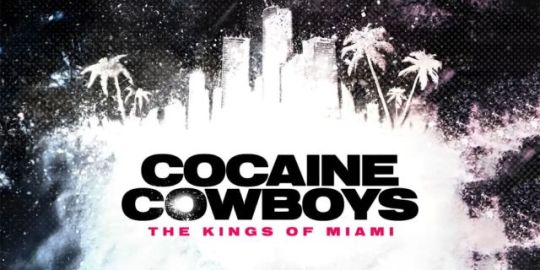
Cocaine Cowboys: The Kings of Miami was among the many exciting new true crime shows to release on Netflix in 2021. The six-part docuseries depicts the rise and eventual downfall of the Miami drug kingpins Willy Falcon and Sam Mugluta. The series showcases part of director Billy Corben’s collection of films beginning in 2006 when he first documented the Miami drug war of the 1970s and ’80s in his feature film of the same name.

Evil Genius reveals the truth behind one of America’s most bizarre criminal cases—the infamous pizza bomber. In 2003, 46-year-old pizza delivery guy Brian Wells died in a strange explosion. It happened after Wells was captured and had a bomb collar placed around his neck before being forced to participate in a strange, scavenger hunt-style robbery. Many questions remain about the case, including the extent of Wells’s involvement, who put the bomb on him, and why. Produced by Jay and Mark Duplass, the show explores all of this in search of answers to this stranger-than-fiction true crime story.

In the Netflix true-crime documentary series, Heist, amateur thieves reveal how they became unlikely criminals. Rather than revolving around the execution of their crimes, the show takes a realistic look at what happens when everyday people decide to break the law. The show’s focus on what led the perpetrators to commit these crimes, and the consequences of their actions, is what makes the series unique.
Related: Netflix: Tiger King Makes Netflix’s True Crime Problems So Much Worse

Originally released in 2015, Making A Murderer follows the murder investigation and conviction of Steven Avery. After serving 18 years in person for a crime he didn’t commit, Avery was finally exonerated, only to find himself behind bars yet again just two years later—this time, for murder. Avery says he didn’t do it, but the courts disagreed. This true-crime show examines the case in hopes of getting to the truth. While some have argued that Making A Murder season 2 may have been a mistake for Netflix, this is still one the most popular true-crime shows ever released on the streaming service.
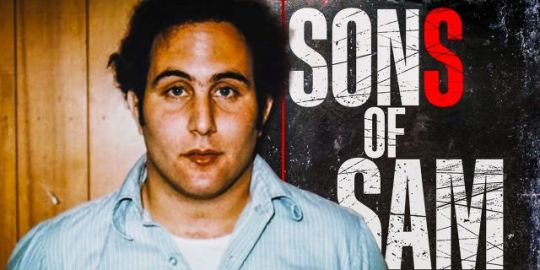
The Sons of Sam: A Descent Into Darkness revolves around journalist Maury Terry’s involvement with the Son of Sam case that captured the nation during the late 1970s. Convinced that David Berkowitz couldn’t have acted alone, Terry becomes so obsessed with finding the truth that it eventually consumes his life entirely. A cautionary tale told through archival footage and interviews with those closest to the case, this true-crime series puts a different spin on one of the most notorious serial killer cases of our time.

A documentary about the opioid crisis, The Pharmacist follows one father’s fight for justice. After the tragic murder of his son in a drug-related shooting in 1999, a grief-stricken Dan Schneider tirelessly pursued his son’s killer. After his theories were dismissed by police, Dan began a personal investigation into the case. Chronicling his journey through decades of audio recordings, Dan eventually finds his son’s killer and uncovers a national addiction epidemic and cover-up along the way.
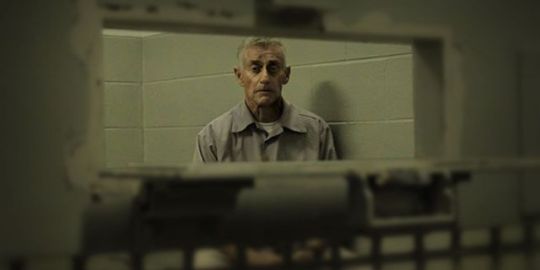
In 2001, novelist Michael Peterson’s wife was found dead at the bottom of the stairs inside the couple’s home. Peterson claimed she fell, but the court wasn’t so sure. Digging deep into the case and Peterson’s past, the docuseries forces Peterson to answer hard questions from his family and closest friends. Above all, The Staircase attempts to answer that nagging question that still remains—did he do it?
Related: How Netflix’s Ted Bundy Documentary & Movie Are Different (& Which Is Better)

Turning away from murder, docuseries Dirty Money chronicles the Wells Fargo accounts fraud scandal, as well as five other stories highlighting corporate corruption and greed. Academy Award-winning director and acclaimed documentarian Alex Gibney directs this thrilling investigative report. The show offers an intimate behind-the-scenes view of how everyday citizens are put in danger by those in positions of power at some of the wealthiest corporations in the world.

Sophie: A Murder in West Cork is a three-part Netflix docuseries that revolves around the 1996 murder investigation of Sophie Toscan du Plantier, a young French film producer who was found brutally murdered while on holiday in rural Ireland. The crime shocked the town and made headlines worldwide, but the case has never been solved. The series takes a look at Sophie’s background and life, as well as the life of the police’s most likely suspect, a crime reporter who covered Sophie’s murder.

This Is A Robbery is not your typical true crime show. Netflix’s four-part docuseries covers the robbery of 13 masterworks of art stolen from the Isabella Stewart Gardner gallery in March of 1990. As it tries to unearth the truth about what many consider to be the biggest art heist in the world, the series explores the underground network of notorious art thieves, the New York Mafia, and murder.

The Netflix revival of Unsolved Mysteries was released on the streaming platform in 2020. Examining new unsolved crimes, the reboot follows a modified format as the popular, original 1990s true-crime series. In honor of its beloved host, Robert Stack, who passed away in 2003, the show has remained host-less in its first two seasons. Fans of Unsolved Mysteries should also check out Cold Case Files and Forensic Files, both of which are also currently available on Netflix.
Related: Every Netflix Original Show Canceled in 2021 (So Far)

Wild Wild Country is the story of one of the most controversial cult leaders few people have ever heard of: Bhagwan Shree Rajneesh. In 1981, the spiritual guru relocated his ashram in India to the Oregon desert. The documentary series explores what happened next, as conflicts between members of Rajneesh’s Utopia and the Oregon locals escalated into a national scandal. Fans of this series may want to check out one of Netflix’s latest true crime collections, Untold, a series of feature-length films produced by the same team, that will release on Netflix in August 2021.
More: Best LGBTQ TV Shows On Netflix Right Now
The post Best True Crime Shows On Netflix Right Now | Screen Rant appeared first on undertheinfluencerd.net.
0 notes
Text
N.S. pharmacies scrambling to find solutions for children's medicine shortage
The Pharmacy Association of Nova Scotia says a shortage of items like acetaminophen and ibuprofen continues to be an issue here and nationally. Some pharmacists are resorting to "compounding" to help serve customers. Tom Murphy has more.
from CBC | Nova Scotia News https://ift.tt/0Y8aWVi
0 notes
Text
Calling All Vaccinators: Closing the Next Gap in Covid Supply and Demand

This story also ran on NBC News. It can be republished for free.
Beating back covid right now comes down to balancing supply and demand.
With hopes pinned to vaccines, demand has far outstripped the supply of doses.
But, as an increasing number of vaccine vials are shipped in coming weeks, the concern about shortages may well shift to human capital: the vaccinators themselves.
“We need to mobilize more medical units to get more shots in people’s arms,” Jeff Zients, coordinator of President Joe Biden’s covid-19 task force, said at a briefing earlier this month.
Already, there have been scattered reports that vaccinators are in short supply in some areas.
“Absolutely, we do need more,” said Tom Kraus, vice president of government relations for the American Society of Health-System Pharmacists, whose members work in hospitals, clinics and large physician practices.
After all, vaccinating America is a huge undertaking.
“We are planning to vaccinate a lot more people over a shorter period of time than we’ve ever done before,” said L.J Tan, chief strategy officer of the Immunization Action Coalition, which distributes educational materials for health care professionals and the public across a range of vaccination topics.
Each year the U.S. vaccinates 140 million to 150 million residents against influenza, “but what we’re talking about now is much more intensive,” he said. For covid, the goal is to get vaccines out quickly to all those eligible in a country of 330 million people.
A state-by-state survey would be required to estimate how many total vaccinators are needed nationally, Tan said.
Still, experts are cautiously optimistic that this won’t be a hard problem to fix, pointing to efforts underway to recruit current and retired medical professionals, as well as medical students and nurses in training.
“As long as we continue to see this interest in volunteering, we should have a sufficient workforce to do it,” said Deb Trautman, president and CEO of the American Association of Colleges of Nursing.
Not just anyone can be a vaccinator. One can’t merely walk into a center and offer to help give shots. The training requirements vary by state.
To boost the effort, both the Trump and Biden administrations, using an emergency preparedness law first adopted in 2005, expanded liability protections.
With the recent expansions, those qualifying include pharmacy interns and recently retired doctors and nurses, as well as physicians, nurses and pharmacists. The government estimates there are about half a million inactive physicians and 350,000 inactive registered nurses and practical nurses in the United States.
States are also greenlighting dentists, paramedics and other first responders, said Kim Martin, director of immunization policy at the Association of State and Territorial Health Officials.
Some are also turning to nursing and medical schools, where faculty and students are often eager to participate. More than 300 schools nationally have signed a pledge offering to help administer the vaccine, according to the American Association of Colleges of Nursing.
The University of Houston College of Nursing, for example, altered its curriculum specifically to prepare students for administering covid vaccines — and teams of students and faculty have helped at community vaccination sites.
Others are joining the effort.
The Medical Reserve Corps, a national network of volunteer groups, has more than 200 units in about 40 states, Puerto Rico, American Samoa and the Northern Mariana Islands assisting with various vaccination efforts, including administering the shots, according to a Health and Human Services spokesperson.
And the military is pitching in, too, with the Pentagon approving the use of more than 1,000 active-duty service members to help the Federal Emergency Management Agency with mass vaccinations sites, the first one set for California.
Although some of these groups give ballpark figures of volunteers, it’s hard to tally just how many have stepped forward in recent months to help vaccinate.
Becoming a Vaccinator
“It should not be left to just anyone that is willing, as there are clinical skills and preparedness that is required,” said Katie Boston-Leary, director of nursing programs at the American Nurses Association.
Even those skilled in giving shots may need a training booster in the war against covid.
When she volunteered, Boston-Leary said, she was required to complete four to six hours of online training across a wide range of topics, from the optimal way to administer intramuscular injections, to specific information about the two vaccines now on the market.
“Even a nurse like me has to go through that training,” said Boston-Leary.
To aid states in setting up training, the Centers for Disease Control and Prevention offered recommendations that all health care staff members receive training in covid vaccination “even if they are already administering routinely recommended vaccines.”
The CDC has different training modules, based on experience level. For instance, there’s a module for those who have given vaccinations in the previous year, but a different one for those who haven’t done so for more than a year. The time required to complete programs varies — people with the most recent experience require less total training time.
Tan said training laypeople with no medical background to give vaccines “is not the way to go.”
Instead, such volunteers can be used to help with logistics, such as directing people to the right areas, managing traffic, moving supplies around and similar duties.
Training programs exist even for people who aren’t vaccinators but assist with storing, handling or transporting the vaccines. That’s important because the two vaccines currently in use — one from Pfizer-BioNTech and one from Moderna — have different storage requirements.
They are shipped in multidose vials, which is not unusual for vaccines. The vaccinators themselves often draw up the syringes out of the vials, said Tan.
To avoid slowdowns as patients move through the lines, some vaccination centers have other trained staffers pre-fill individual syringes. Anyone doing this task should be “someone trained in administering vaccines as well,” said Tan.
At the clinic where Katie Croft-Walsh, 65, volunteered recently in San Antonio, her only job was to administer the vaccine. Other volunteers took care of registering patients, pre-filling the individual syringes and other logistical efforts.
She decided to volunteer after hearing that help was needed. The move came with a bonus: She would get the vaccine herself at the end of her first day participating, something she already qualified for based on her age but had been unable to secure.
A practicing lawyer, Croft-Walsh previously worked as a registered nurse and kept her license current by taking required courses each year since leaving her hospital job in 1998.
Training occurred on her first day at the mass vaccination site and covered details about each type of vaccine, along with the types of syringes available, the right place to inject the dose and other information. Her group, which she said included nurses, dentists, pharmacists and upper-level nursing students, were trained and overseen by health department physicians.
The patients were all thrilled to get a dose.
“Everyone was very kind and nice,” even if they had to wait a bit in line, she said.
She liked the experience so much that she has volunteered at more clinics — and plans to start volunteering with fire departments as they begin community clinics in her city.
“It made me remember why I went into nursing in the first place,” said Croft-Walsh.
Remember, No Squeezing!
To ensure safety, training is important, Martin of the state health officers group said. It’s not that hard to give an intramuscular injection, but you need to place it in the right spot. For adults, that area is in the deltoid muscle, “not too far up the shoulder, not too far down,” she said, both to avoid injury and to make sure the vaccine goes into the muscle.
Training videos show vaccinators how to find the ideal location, first locating the bony point in the shoulder, then measuring two or three finger widths down and placing the needle in the middle of the arm.
Administering an intramuscular vaccine too high on the shoulder can cause a rare and painful injury. Such injuries were more common years ago when influenza vaccines were first rolling out, said Tan of the immunization coalition. Training on proper technique helped reduce cases since then, he said, and is also part of current efforts to train vaccinators.
It’s also important not to pinch patients’ arms when administering the vaccine, said Tan, responding to a question about a hashtag making the rounds on Twitter called #DoNotSqueezeMyArm.
For intramuscular injections to be most effective, the needle needs to penetrate the muscle, not fat.
“When you squeeze the arm, it pushes up the fat layers,” said Tan.
Those getting the vaccines, he said, can play a role, too.
“I encourage patients to ask questions,” said Tan. “If they’re concerned their arm is being squeezed, speak up. Not in a hostile manner, but say something like, ‘Hey, I read this thing about not squeezing arms. Can you explain why you’re squeezing mine?’”
Kaiser Health News (KHN) is a national health policy news service. It is an editorially independent program of the Henry J. Kaiser Family Foundation which is not affiliated with Kaiser Permanente.
USE OUR CONTENT
This story can be republished for free (details).
Calling All Vaccinators: Closing the Next Gap in Covid Supply and Demand published first on https://smartdrinkingweb.weebly.com/
0 notes
Text
New Post has been published on Vivan Life Sciences
New Post has been published on https://www.blog.vivanls.com/2020-was-a-year-of-discovery-for-india/
2020 was a year of Discovery for India !

The COVID-19 pandemic has brought to the fore India’s national character for the entire world to behold and 2020 will be known as a year of internal discovery rather than of external disruption, according to Prime Minister Narendra Modi.
Across the world, people have expressed wonder at the way in which Indians, whether poor or rich, young or old, rural or urban, have shown the ability to be responsible, disciplined, focused, law-abiding, patient and composed during a crisis of unprecedented proportions, he said.
“Some may call the year 2020 as a year of external disruptions due to the pandemic. But I firmly believe that 2020 will be known, not as a year of external disruption, but as a year of internal discovery, for our society and for our nation,” Modi wrote in an exclusive article in the Manorama Yearbook 2021.
“Adversity not only builds strength but also brings out our true innate character. This global pandemic has brought to the fore India’s national character for the entire world to behold, as a resilient and united nation,” the write-up titled “Aatmanirbhar Bharat: Transforming India” said.
“India emerged as a pharmacy to the world, sending life-saving drugs and medicines far and wide, at the same time ensuring no shortage to our own people.
“After the pandemic struck, in no time, our COVID warriors rose to the occasion and led India’s fight from the front. Remarkable efforts on a war-footing made India self-sufficient in PPE production,” the prime minister wrote.
Countless unsung heroes, from ambulance drivers to pharmacists, from security personnel to small neighborhood vendors, kept our lives going even during difficult circumstances, while carefully maintaining social distancing, wearing masks and adapting digital payments, he said.
Modi asserted that a slew of reforms across various sectors are strengthening the country’s development trajectory as against earlier reforms that used to be “hostage to political expediencies”.
Highlighting the significance of Aatmanirbhar Bharat, he said it means an India which is more competitive, an India which is more productive and an India which celebrates local talent.
“An Aatmanirbhar Bharat will increase India’s role in global supply chains by attracting more global businesses to India to take full advantage of India’s policy stability, low taxes and skilled human resources,” he said.
Modi also wrote that the COVID-19 pandemic has reinforced the ability of technology to be a valuable bridge and from multi-nation summits to multi-national companies, everyone’s work had to go online.
He was of the view that in the coming year, there will be an even greater focus on self-reliance and resilience in technology.
The yearbook is power-packed in 25 sections and has write-ups on post-COVID careers, the cost of COVID-19 on the Indian economy, work from home, Indo-Pak and Sino-India relations and attitude and aptitude among other topics, says chief editor Mammen Mathew.
“Looking back at 2020 we can say that we have come through quarantines and lockdowns by maintaining social distancing, self-masking, sanitising, despite disruptions and confinements in our personal space,” he writes in the editorial.
Reference: Livemint.com
0 notes
Link
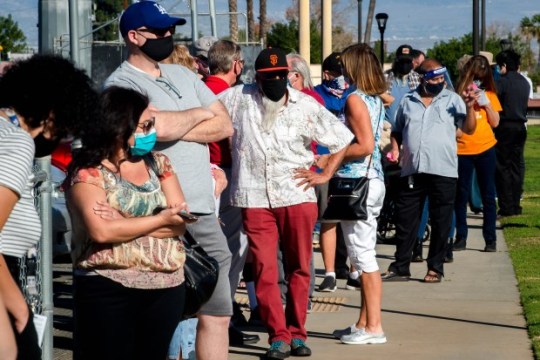
People wait in line to receive the COVID-19 vaccine at Corona High School, a designated Riverside County vaccination center for people in Phase 1B, in Corona on Thursday, Jan. 14, 2021. (Photo by Watchara Phomicinda, The Press-Enterprise/SCNG)
In Miami, priority access to COVID vaccines was dangled as a lure to big hospital donors.
In New York, hospital workers laboring from home cut in front of their frontline colleagues on the COVID-19 vaccine line.
In California, teachers at the wealthy Los Gatos Union School District were urged — by their superintendent — to masquerade as health care workers to get vaccines ahead of schedule.
Scarcity of vaccines amid a deadly global pandemic is fueling fears of a black market that could inflict great harm on public health and confidence, where potentially stolen, spoiled or fake vaccine is sold to those who can afford to pay while the real thing is in short supply in communities most heavily impacted by COVID, experts said.
“What we see is divergence — stolen, falsified and substandard product that undermines the health of the people who take it and the public health of the community, damages the brand of companies and torpedoes efforts of government to get the economy up and going,” said Nikos Passas, a professor in Northeastern University’s School of Criminology and Criminal Justice, in a discussion on the vaccine black market by the health news site STAT.
“We see vaccine tourism, fake medicines, fake products, with multiple victimization,” Passas said.
While there have been reports of wealthy Angelinos pressing concierge medical groups for early vaccine access, line-crashers at mass injection sites and non-medical family members snagging shots meant for health care workers, officials at the California Department of Public Health and local district attorneys’ offices said significant black market activity hasn’t hit the radar yet in the Golden State.
Fraud tip lines are at the ready, however, to take reports of any untoward activity that might surface.
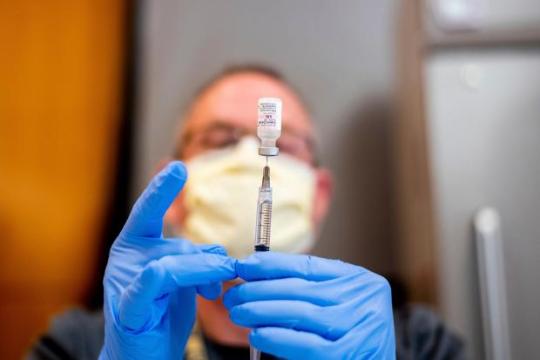
A pharmacist draws saline while preparing a dose of Pfizer’s COVID-19 vaccine in Sacramento. (AP Photo/Noah Berger, Pool, File)
“The things I’m concerned about are not necessarily unlawful, even though they’re unethical,” said Alison Bateman-House, an assistant professor of medical ethics at New York University. Like the doctor who puts his wife on the payroll as a temporary worker so she qualifies as a health care worker, or the person who takes his aging parents to a clinic in a poorer neighborhood, or across state lines, because vaccine is easier to get there.
“When you start having these fractures … you engender a lack of trust in the system,” she said. “At this point in time, we’re already dealing with the fastest vaccines ever created and brought to production in human history. There are people authorized to get them, but declining. You already have this very tenuous situation, and anything to further undermine it is going to cause more problems.”
Poor prep
The seeds for a black market were sown amid the general chaos of the pandemic, the government’s ham-handed management of the crisis, and long-standing inequities in health care access, the experts say.
The U.S. Government Accountability Office — an independent federal agency that examines how taxpayer dollars are spent and provides Congress with objective, nonpartisan information to help the government work more efficiently — would agree. It has been trying to prod officials toward a more cogent response to the pandemic since last summer.
“Congress’s watchdog,” as the GAO is known, pumped out four blistering critiques of the federal government’s efforts last year and made 31 recommendations on how to make things better. The government embraced only four of them.
On Thursday, Jan. 28, the GAO released yet another critique with 13 more suggestions. “GAO remains deeply troubled that agencies have not acted on recommendations to more fully address critical gaps in the medical supply chain,” it said.
While acknowledging there have been some steps forward, “GAO underscores the importance of developing a well-formulated plan to address critical gaps for the remainder of the pandemic, especially in light of the recent surge in cases,” it said, charitably adding, “implementation of GAO’s recommendation concerning the importance of clear and comprehensive vaccine distribution and communication plans remains a work in progress.”
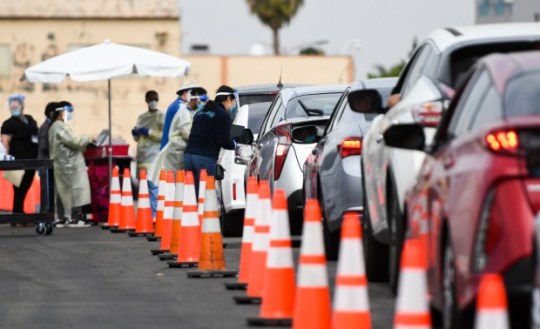
Cars line up for the drive-up COVID-19 vaccination site at the Los Angeles County Office of Education in Downey January 19, 2021. (Photo by Keith Durflinger, Contributing Photographer)
Slow-walking fixes to program integrity — particularly in Small Business Administration and Department of Labor programs — “creates risk of considerable improper payments, including those related to fraud, and falls far short of transparency and accountability expectations.”
One year into the pandemic, the nation still needs a “supply chain strategy” for everything from testing, masks and other protective gear to vaccines, it said.
“As the new Congress and administration establish their policies and priorities for the federal government’s COVID-19 response, GAO urges swift action,” it said.
Much at stake
Knock-off designer bags are one thing. Knock-off vaccines are another altogether.
The integrity of vaccine product that ends up in marginalized communities is at the top of the worry list of Glenn Ellis, visiting scholar at the National Bioethics Center at Tuskegee University and bioethics fellow at Harvard Medical School.
“There are contaminated products being sold on the street, supposedly representing something else,” Ellis said. “What is the integrity of refrigeration and storage through this process?”
Passas warns of a darker phenomenon — “vaccine nationalism.”
Canada has reserved more doses of vaccine than it has people to vaccinate. The European Union is poised to block export of vaccine to other nations around the globe in the face of shortages.
“These are the kinds of things that cause security concerns, that constitute institutional racism,” he said. “Those worry me.”
The Consumer Financial Protection Bureau put out a scam alert on Friday, Jan. 29, urging people to beware of scams offering early access to vaccines for a fee, phishing scams via email or text with phony vaccine information, and scammers peddling fake versions of vaccines.
“You can’t pay to get early access to the vaccine,” the CFPB said in its alert. “Medicare covers the cost of the COVID-19 vaccine. COVID-19 vaccines are also free to others throughout the country, although providers may charge an administration fee. Don’t share your personal or financial information if someone calls, texts, or emails you promising to get you the vaccine for a fee.”
Those who suspect fake, or misuse of, vaccine supply can report it to local police departments or district attorney’s offices. Consumer fraud units of county district attorney’s offices can be reached at the following numbers: Orange, 714-834-6553; Riverside, 951-955-0764; San Bernardino, 909-891-3330; and Los Angeles, 213-974-3512.
Related Articles
Q&A: When the jobs dried up, Maintco Corp. switched to COVID-19 safety
Path Forward: How COVID-19 ‘immunity certificates’ could restore our lives or divide us
Coronavirus vaccine’s second dose has more side effects, but worth it, recipients say
Riverside employees listed as ‘emergency services workers’ get coronavirus vaccine
Riverside County administers more than 75% of its coronavirus vaccinations
-on January 30, 2021 at 11:10PM by Teri Sforza
0 notes